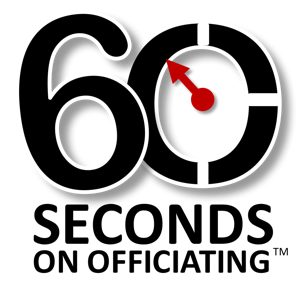
Photo courtesy of Garry Thompson
The Difference Between Winning and Losing
… may be how you communicate as a crew at the end of a game.
As a matter of best practice and extreme importance in a scholastic contest — officials (as a crew) must be extremely clear in their communications at the end of a game and do not leave the “playing area” until ANY problems, questions, or controversies around scoring / timing plays are resolved.
Here’s the situation with a bit more details surrounding this NFHS contest.
The visiting team is leading by just one point with just a handful of seconds left in the 4th quarter.
The home team dribbles the length of the court and releases a try for goal just around the same time the horn sounds at the expiration of play.
The noise levels in the gym are so high, the Trail official (opposite the table in a crew of two) in perfect position to make the decision of whether the ball was released prior to the horn sounding — had extreme difficulty in hearing the sound of the buzzer.
The Trail subsequently signaled a successful two point goal which put the home team ahead and immediately ran off the court to avoid the anticipated rush of fans.
The lead official in this two person crew heard the horn clearly and in his mind knew the try was NOT released prior to the buzzer sounding. To compound the situation he also did not see the trail official’s signal to score the goal. He “assumed” the goal was not scored as they met just off the court.
With both the home and visiting fans screaming while sensing a victory, the two officials ran down the stairs into the basement locker room. Before they could catch their breaths — the site administrator and athletic director comes into the locker room and asks — “Did that last shot count or was it after the buzzer?”
The Referee who was in the lead position blurted out — “No way, that was obviously after the horn sounded.” Which it definitely was.
The Umpire that made the ruling … just said, “I think we have a problem.”
The only person in the gymnasium that saw it differently was the Trail official and was the umpire that scored the try.
So now what?
By NFHS rules, even though the lead official (Referee) could have canceled the score IF the officials would have conferred before leaving the visual confines of the playing area — the final score (albeit wrong) IS OFFICIAL and cannot be changed at this time.
The key here is … “once the entire crew (that means both or all three) leave the “confines” you must live and die with the score as it is approved. While this doesn’t sound fair it points to the importance of approving the score prior to leaving the playing area.
An ounce of prevention here is worth a pound of headaches down the road.
- Make sure to come together at the end of a game if there are ANY potentially controversial scoring plays or timing issues.
- Ask questions … “Did you score that goal ? … Was that a two or three point try? … Did you see any time on the clock when I blew my whistle for the foul? … etc etc.”
- The Referee should “visually” look at the scorers table before exiting and make sure they are not waving for your attention or have particular questions regarding the counting or canceling of a score.
- There is no need to “physically” go over to the scorer’s table. Visual contact and confirmation is enough. Going close to the table (and coaches) just invites trouble. If the table needs your help, then by all means go attend to that problem.
- You should always leave the playing area “together” as a crew. Have a plan and discuss your “post-game egress” to the locker room in case of potential crowd eruption spilling onto the court.
This ugly situation could have been prevented by better crew communication, visual eye contact between partners, and delaying your exit to make sure there are no scoring issues before approving the score and leaving the confines of the playing area.
Hopefully this won’t happen to you … but if it does, it could be the difference between winning and losing.
Rules Reference
NFHS Casebook 2.2.4 Situation C

60 seconds is a great resource. In the play above about not knowing if it was a score or not, If the lead was not watching the ball/shot, there would not have been any problem with this play. It was the Trail’s call and not the Leads. The lead, in a 2 man game, should be watching the players in his PCA from the chest down and not at the basket.
the confusing came when they didn’t communicate, before leaving the confines of the game, in a very close game.
What if this happens at the halftime buzzer. This actually happened to me in an important game where the center who was away from the table counted a basket which I knew was late. I was the referee, but it was his call and I thought we should live and die with his judgment. Should I have come out before the 2nd half and changed the score?